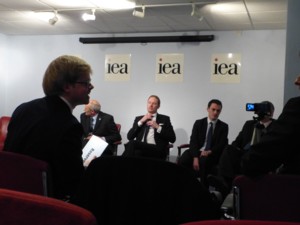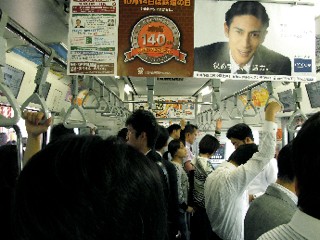We are developing the social individualist meta-context for the future. From the very serious to the extremely frivolous... lets see what is on the mind of the Samizdata people.
Samizdata, derived from Samizdat /n. - a system of clandestine publication of banned literature in the USSR [Russ.,= self-publishing house]
|
I have long admired the libertarian historian and activist Stephen Davies, my previous posting here about him being this one, in connection with a talk he recently gave to Libertarian Home, in the superbly opulent setting of the Counting House‘s Griffin Room, in the City of London.
Here is a photo of Davies that I took that night:
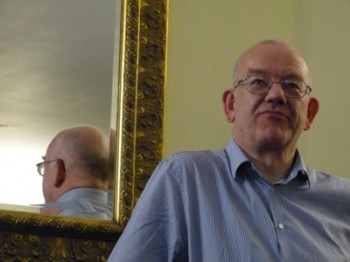
Here is another, together with a photo of someone else also photoing him.
The Davies talk was predictably excellent, and this on a day when he had also given another talk elsewhere in southern England somewhere, to a bunch of sixth formers. I know this because I happened to share a tube journey with Davies afterwards, during which we talked about, among other things, his day, and why he was so very tired. I don’t recall where this other talk was, but do recall that it was definitely out of London and that Davies also organised for three other speakers to be present, as well as himself speaking. All this being part of the networking and speechifying enterprise that Davies masterminds from the IEA, along with his IEA colleague Christiana Hambro. LLFF2013 was but a London manifestation of a nationwide libertarian outreach programme.
The way Davies seems to operate is that he has a number of set-piece performances on particular themes, each of which he delivers pretty much off the cuff, with almost intimidating fluency but which he will typically have done several times before you get to hear it. So, when a particular audience assembles, they get to choose from a menu. There’s that history of libertarianism talk, which Davies did for Libertarian Home, having previously done it for the Essex University Libertarians and presumably for plenty of others besides. There is a healthcare talk, which I heard Davies do at LLFF2013, which he also did for those sixth-formers earlier in the day of the Libertarian Home performance. And there are several more of course, which I also asked him about, during that tube journey. I know. He was by then just about dead on his feet, but just sitting there and not asking such things would have felt even ruder than picking his exhausted brain.
A particular favourite of Davies himself, and of me now that I have heard about it, concerns history dates.
→ Continue reading: Steve Davies supplies some different and better history dates
The pub chain Wetherspoons, whose chairman Tim Martin seems to be of sound mind, is opening a pub at a motorway service station. Cue whining and moaning from assorted fake charities and do-gooders of the kind who complain about the “message” that allowing such a business to exist “sends out” and advise drivers against even one drink with lunch because, though it does not follow, people who drink to excess cause traffic accidents.
Say Wetherspoons:
“We believe the majority of people that use the pub to drink will be people that aren’t driving – coach parties or people travelling with others.
“We won’t be asking them whether they are driving. It’s up to them.”
This is individual responsibility that alcohol lobbyists do not acknowledge.
And I also (see below) recommend this video. I won’t describe it at length. Suffice it to say, as David Thompson does say, that you need to watch it right to the bitter end. DT found it here, where viewers were also urged not to miss the end.
An early DT commenter declared that he saw how things would end right away, but I didn’t.
Today, at 1.54pm in the early afternoon, a friend of mine took this photograph at Oxford Circus, in London W1. We were talking on the phone and she mentioned that there was this important looking hearse driving by. I said can you take a photo of it? She managed just the one, and this was it:
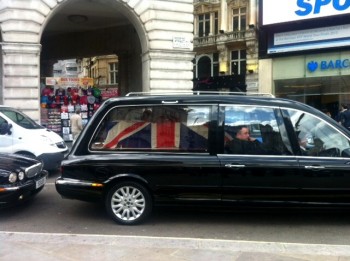
Not having paid much attention yesterday to the Thatcher Funeral, and being a very inept Googler for information about such things, I am unsure about just what this is a photo of. The internet is full of news about what happened yesterday, but seems (to me) to be silent about any Thatcher related activity happening in London today.
Thatcher was cremated at Mortlake Crematorium yesterday afternoon:
Baroness Thatcher was this afternoon cremated at Mortlake Crematorium in South-West London.
After a reception for the guests at her ceremonial funeral, the body of the former Prime Minister was driven from St Paul’s Cathedral to the suburban district.
Her ashes are due to be interred next to those of her beloved husband Denis, who died in 2003, at the Royal Hospital Chelsea.
The hearse in the photo that my friend took certainly looks like the hearse on duty yesterday, as featured in the pictures at the far end of the link above. And who else, besides Thatcher, would merit a Union Jack?
So I’m guessing that this was indeed the Thatcher ashes, on their way to Royal Hospital Chelsea. If so, by a somewhat circuitous route, back through the middle of London.
But am I right about what this was? Or is egg is even now assembling itself on my face?
Mick Hartley, who has been watching North Korea closely for years, senses that things may be about to explode, sooner rather than later:
Under the departed Dear Leader, there was at least some measure of balance. The Songun military-first principle held sway then as now, of course, and the level of vitriolic rhetoric aimed at South Korea and the US and Japan was constant and unrelenting, but there was some sense of a cunning plan; of a canny political operator at work.
Now, though, with the new Fat Controller Kim Jong-Un, there’s a strong feeling that it’s all getting out of control. As a sign of his weakness and insecurity, and doubtless under all kinds of internal pressures, and in-fighting within the top brass which we don’t know about, he just keeps pressing the same buttons that worked for his father, but he has to press them harder and harder. Up with the militarisation; up with the vicious rhetoric; up with the provocations and the bluster. He doesn’t know what else to do. Now the whole country’s on a war footing, the economy – such as it was – is imploding, and maybe for the first time in the history of the DPRK there’s a sense that the suffering people may not be prepared to tolerate this increased hardship much longer.
The logic of his position, then, may force him into some reckless action. He’s backed himself into a corner. South Korea’s western islands are looking increasingly vulnerable. If he doesn’t do something he’s going to look weak, and all that hardship is going to look like it was all for nothing to the wretched populace. And, as the economy tanks, he has to do something sooner rather than later….
I recommend also reading Hartley’s earlier piece, linked back to there, which does indeed link in its turn to reports about the vulnerability of some South Korean islands, but which is itself a copy-and-paste posting about what China is preparing to do about all this. Preparing to invade North Korea, basically, and racing against time. As always, when states like China build railways (in fact when almost any state has ever built a railway), the thinking is not just economic; it is also military.
China was and remains content to sponsor a North Korea that is vicious and strong. But a North Korea that is vicious and weak, to the point of recklessness, is a serious threat to China’s interests.
It says everything about the state of life for regular people in North Korea that if and when the Chinese do invade, the Chinese may well be greeted as liberators rather than as another bunch of predators.
I like photographing new London buildings, the taller the better. And I am also very fond of photographing cranes, which can be quite dramatic but will soon be gone. So, when a new tower started getting built just across the Thames from me, all the while lovingly tended by just the one very tall crane, I photoed it, quite often.
Here is how the tower and its crane looked in May of last year.
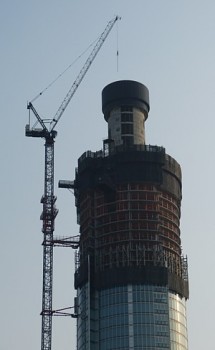
That’s a shot taken from Vauxhall Bridge.
Here is a somewhat more artistic shot of the top of the tower, and its crane, taken last November, from Vauxhall Bridge Road, which is to say from rather further away:
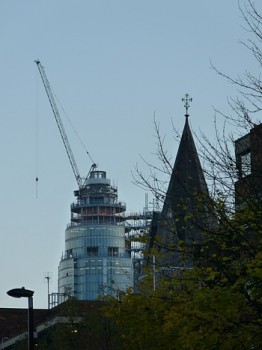
But now look at them, as photoed by me this afternoon:
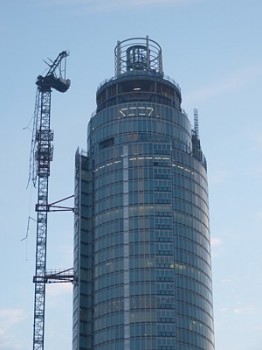
The tower is okay, but the crane is in a sorry state.
During this morning’s rush hour, when it was very misty, a helicopter smashed into the crane. As you can see, the crane suffered badly, but what happened to the helicopter was far worse. It lost its blades, plummeted to the ground in flames, killing its lone occupant, the pilot, and another person on the ground. Blazing aircraft fuel was all over the place, and nearby cars were engulfed in the resulting flames and themselves also exploded. Had it happened rather later, when the road where all this happened would probably have been traffic-jammed, it might have been an order of magnitude more horrific.
Not surprisingly, this is one hell of a news story.
This afternoon I got nowhere near where all this drama had happened, and didn’t seriously try to. But a zoom lens was all I needed to photo what happened to the crane, and this will surely get photoed a lot, for as long as it stays up there for all the world within about half a mile to see. I’m guessing that there is going to be lots of tidying up and sorting out to be done at ground level, before it will become possible to replace the crane, and finish building the tower.
Terrible. Deadly. And, given how costly it is when a major building project is at all seriously delayed, as this one surely will now be: very expensive.
LATER: A better view of the ruined crane, in the form of an expanded detail of the crane itself, minus most of the tower, here.
Today a friend from way back who is a structural engineer by profession dropped by. He is semi-retired now, but was not so long ago a pretty big cheese in the bridge designing trade. He still has quite a bit of influence on bridge designing, albeit rather less now than he used to have.
He told me of an engineering bee, concerning train safety, now buzzing about inside his head.
Trains are, on the whole, he said, very safe. But apparently level crossings are the big train exception. A trickle of deaths? A rather big trickle, he replied. “Scores every year” was the phrase I recall him using. I don’t know if that’s quite right, but level crossing deaths are certainly a big deal in Britain.
Perhaps partly because he is a bridge designer, my friend believes that where possible and where not too disruptive and expensive, level crossings should be replaced by … bridges.
Trouble is, there is an acronymic organisation (I think he was talking about this one) concerned with British train safety, which demands very large clearances, both upwards and sideways, for all new road bridges over railways. And it takes only a small increase in a demanded clearance size to require a greatly more elaborate and expensive bridge. Which means that a lot of bridges, that might be built, aren’t.
Partly this demand for big clearances is because at some future date the railway line in question might be electrified, and in the meantime, space must be left under all bridges for that.
My friend says: Fine. In the meantime build smaller but temporary bridges. If electrification ever happens, replace these small bridges with bigger bridges. (Or, I suppose, go back to having level crossings, although that possibility wasn’t mentioned.) Meanwhile, save many lives now lost at level crossings.
But partly, the reason is a safety consideration of another kind. Says the acronymic organisation: all imaginable train wobblings, including the most unlikely, must be allowed to occur under all future bridges without any train afflicted by such wobbling hitting the bridge, even though many existing bridges allow for no such wobblings, with no detectable effect on train fatalities.
Result? The rather big trickle of deaths at level crossings goes on, and on, and on. In the pursuit of even more perfect safety where perfect safety has pretty much already been achieved, a closely related and very unsafe circumstance is caused to persist.
The pursuit of safety, badly done, is resulting in the persistence of unsafety.
When people now speak, as they so often now do, of “health and safety gone mad”, this is one of the things they surely mean. It isn’t just that safety is pursued and damn everything else. Safety is also pursued in accordance with mindless rules, that have the effect of reducing safety itself.
Something tells me that this is not the only example of such perverse safety thinking.
This blog has reported repeatedly on the Paul Chambers case. Quickly, Mr Chambers was convicted of a criminal offence for stating on Twitter that he would “blow (Robin Hood airport) sky high” if it did not reopen soon after bad weather, because he wished to catch a flight in order to see his girlfriend. This was an obvious joke, and was understood as such by absolutely everyone, but he was convicted anyway, lost two jobs as a consequence etc etc, before being finally cleared on appeal to the High Court.
News out today. Slightly before this incident, members of the same security staff at that same Robin Hood airport in South Yorkshire came close to actually blowing the airport sky high. They did this through utter incompetence, by insisting on opening and inspecting a shipment of anti-tank ammunition that had been flown into the airport, despite having no expertise or understanding of how to properly do so.
Guess what? The security staff in question were not convicted of anything. In fact, by law they cannot be prosecuted in such circumstances. Funny, that.
Yesterday, as earlier reported, I attended an event about road pricing. It was typical IEA. Men in suits and ties with irreconcilable beliefs took it in turns to be irreconcilably polite about everything, while other men in suits and ties listened with equal politeness:
There are some of the men in suits and ties waiting their turn to be polite. And look, one man in a suit and a tie is even straightening his tie, James Bond style, although there the resemblance ends. That’s Oliver Knipping, co-author, together with Richard Wellings (the man in a suit and a tie on the right whose face is blocked out by the video camera) of a recent IEA publication entitled Which Road Ahead – Government or Market? Do you see what they did there? Which road, as in policy, metaphorically speaking, for dealing with roads, as in roads, literally.
I am being much too rude. It was actually pretty interesting if you like that sort of thing, which I only somewhat do, hence my rudeness. I went because I knew that although I would be rather bored during the event, I would afterwards be glad that I had attended, and so it has proved. I got a copy of Which Road Ahead for only a fiver, and better yet, I met a man with a blog, called Road Pricing.
I like road pricing, for the same reasons I think that governments shouldn’t give away train tickets to everyone just because the train system is government owned and/or government controlled and people have already paid for it that way. What if some people don’t like trains and never use them? It’s not fair. Without journey pricing, the trains will get even more impossibly crowded. Privacy? That argument was won and lost when they introduced number plates, I reckon. A man called Gabriel Roth was quoted as saying that the road systems of the world are the last bastions of Soviet style central planning. Which isn’t true. What about central banking? But I like the sentiment. This is a product for which people queue for the product on top of the product thereby destroying the product. That can’t be the right road ahead, now can it?
Scott Wilson, the Road Pricing blogger, agrees. But you won’t read many arguments at his blog about why road pricing is good. What you will read is reports about how road pricing is being done in various parts of the world, well or badly, and criticisms of places where it is being done badly, like, surprise surprise, the UK. In that posting there is a picture of people being charged to get across the Thames which makes you think, not road pricing, but: crossing a national frontier, of the sort that is taken seriously.
I ought to have known about this blog two years ago, when it started. But no matter, now I do. This is the kind of thing that you learn if you go to rather boring meetings instead of just staying home glued to a computer, the way I am now. Besides which, a blog is merely a blog. If you actually meet the man who runs it, see his suit and his tie, and hear him talking, quite intelligently, that makes you actually want to pay attention to his blog.
“I fly out of Monterey airport, a small airport, a lot and so I’ve gotten to know a number of the TSA employees. This morning, on my way to Miami [I’m writing this from LAX], the “gatekeeper” who asks for ID told the man in front of me, after looking at his ID, that he didn’t have to take off his shoes. When it came my turn, I asked her if I had heard correctly. She said, “Yes, as long as you were born in 1937 or earlier.” “I’m not there yet,” I said. Then I ended up behind him in the next line where you put your items on the conveyor belt. “Well,” I said to him, “I know something about your age.” He grinned and said, “Yes, it seems as if there’s a little common sense sneaking back in.” The TSA guy, whom I also recognized and who also probably recognized me, grinned and said, “Shhh, don’t mention the c-word.” We all laughed. A nice little moment.”
David Henderson, at Econlog.
When I recently flew into San Francisco airport, the queues were long but – and this might just be my being lucky – the guy who checked my passport and details was friendly, helpful and efficient. (He was ex-Air Force and did his military service near where I was brought up, a fact that he told me with great delight). Perhaps someone has told the TSA to improve.
The traffic in the blackout areas of Manhattan is lawless in the most literal sense: the traffic lights aren’t working, so the law cannot be applied as usual. But “lawless” doesn’t seem to be a fitting description; the driving seems better-behaved than usual. We’re so used to seeing people act under a system of government rules that it’s easy to assume that without the rules, everything would descend into chaos. But perhaps free people are generally capable of acting decently on their own. Of course, that’s never going to be universal; but then, people break the law too. In fact, a dense set of rules tempts people to see how close to (or how far across) the borderline of legality they can go without being penalized. In the absence of governmental laws, people might focus more on other kinds of laws: social norms and ethics.
– This quote was, at the time I reposted it here, prominently featured near the top of Instapundit. But Instapundit moves fast, especially now, when there are about half a dozen of them and they’ve a presidential election to be blogging about. So the above wisdom will soon have been and gone. It deserves to linger longer, I think, and here, it will. A little longer anyway.
Instapundit found it here, and also links, again, to a piece saying that too many traffic rules can make us less safe.
For traffic rules read rules of every sort.
A couple of weeks ago the government announced (with pens hovering over contracts) that it was prematurely ending the process for awarding the West Coast Main Line (WCML) franchise. This came after Virgin – the loser – initiated legal action to force the government to disclose why it had provisionally awarded the contract to First. During the process of preparing for the case the Government discovered that it had got its sums wrong.
We can argue that it shows that the government is incompetent. We can argue that it shows that Beardie is not a man you want to mess with. We can possibly argue that over-optimistic assumptions about the economy have a lot to do with this. And we can certainly argue that this creates a lot of uncertainty and this is a bad thing because train operators will not be able to make any plans.
But really this is wood for the trees stuff. The fact is that the government (or, to put it another way, the violent part of society) should have nothing to do with the railway. Decisions about the railway should be made by the market (i.e. the peaceful part of society).
Hence, we shouldn’t have franchising, or subsidy, or the split between the wheel and the rail. Yes, unbelievable as it may sound to the uninitiated, in Britain train operators are not allowed to own the track and track owners (or owner – there’s only one) are not allowed to run trains. Railways should be liberated from the state and allowed to stand or fall on their own merits.
My guess is that they will stand (or at least the WCML will). I’ve just returned from Japan where the railways were (mostly) liberated from the state 25 years ago. Trains are frequent, clean and modern. The main railways are profitable.
At this point people someone’s bound to complain that Japanese trains are overcrowded. What about all those people pushers? Every time I’ve been in Tokyo (this was my fourth trip) I’ve tried to find them and haven’t succeeded yet. True, most people have to stand in the rush hour, and from time to time things get very uncomfortable but much the same is true of London too. And for the same reason: fare control which depresses the price and increases demand.
Yamanote Line train somewhere between Shinagawa and Shibuya 0730, Thursday 11 October 2012:
|
Who Are We? The Samizdata people are a bunch of sinister and heavily armed globalist illuminati who seek to infect the entire world with the values of personal liberty and several property. Amongst our many crimes is a sense of humour and the intermittent use of British spelling.
We are also a varied group made up of social individualists, classical liberals, whigs, libertarians, extropians, futurists, ‘Porcupines’, Karl Popper fetishists, recovering neo-conservatives, crazed Ayn Rand worshipers, over-caffeinated Virginia Postrel devotees, witty Frédéric Bastiat wannabes, cypherpunks, minarchists, kritarchists and wild-eyed anarcho-capitalists from Britain, North America, Australia and Europe.
|





